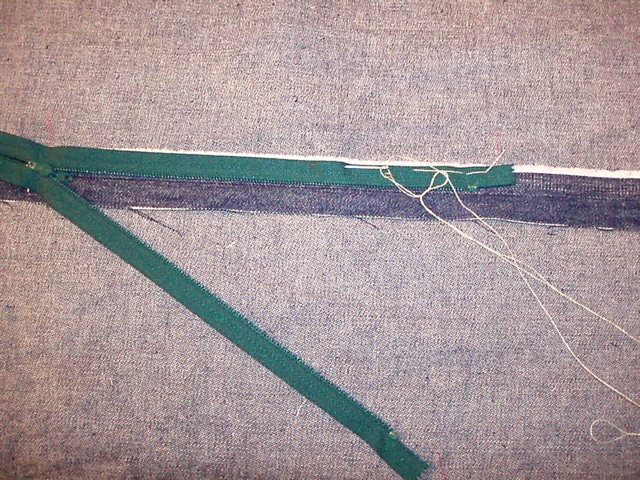Like anyone who sews, we all know the important part of sewing is pressing. It starts with preshrinking the fabric prior to cutting the fabric, but also the pressing which takes place in the process of sewing the garment.
Ann already showed in Threads magazine issue 126 how to use some pressing tools and if you missed that article you can see Ann’s video clip Pressing tools
My pressing equipment: a vacuum suction pressing board , steam iron with a 3,5 liter water tank, the sleeve board is turned under the board .My pressing board is 116 cm long ( 45 inch) and 38 cm wide ( 15 inch) The pedal on the ground is used for the suction function.My press iron has a Teflon cover.

You can see the sleeve board ready to use.

My singer press which I use for fusing interfacing

Besides the use of the oval shaped edge of the pressing and sleeve board, I use several pressing tools, like this large tailor’s ham for any contoured shapes or curves like princes seams in jackets, coats and dresses.

This small one , which I covered on one side with a piece of wool crepe fabric I use for bust and waist darts and collars, sleeve cap easing etc.

I have a June Tailor hamholder but I hardly use it, maybe because it does not fit my small tailor’s ham very well. Probably the size of the US tailor’s hams are different than my Dutch one.

You can see the difference of the two hams in size now they are on top of each-other.

A press buck ( in Dutch called pers bok) which has a different shape, straight lines and curved corners. The buck has a wooden base and legs, the size of the rectangle is 31 cm ( 12,5 inch) wide 22 cm ( 8,5 inch) the padding is 5 cm thick ( 2 inch) The total height is 23 cm ( 9 inch) which is lower than the all known oval shaped ham.
The advantage of this press buck is the different shape and size above the other 2 hams.Use for pressing seams open like shoulders, bust area, neckline, collars and darts .
I bought this buck last year for only € 16.00 it is a used one but still in a very good condition. New ones costs about € 50.00. Tailor hams are expensive but will last a lifetime.

Point presser/clapper is a great tool to press seams open and to beat the steam into the fabric to flatten bulky edges.

Point turner to press open for the hard to reach seams where the point presser is of no help.

But also a wooden spoon is a great tool, even a wooden chopstick can be helpful.

Also a toothpick or large embroidery needle with a blunt end helps to press a dart open,


I inherited this press block from my grandfather who was a tailor but I only show you this because it is old one (about 80 years) and not very smooth anymore , but I keep this for sentimental value.

I asked a timber to make me some new press blocks from steamed beech wood because the advantage of steamed beech wood is, it will not bend out of shape .

The large block is great for pressing seams open like pants or any long seams, and I use those blocks to flatten seams while cooling down.
You can see a detailed picture of the shape of these blocks here, the small one is a rectangle while the large one is a curved one. They can also be used by pressing the seams open or to flatten the edges from a jacket or coat while the fabric is cooling down.

The seam roll is made from a Saturday newspaper tightly rolled and covered with 2 layers of fabric, the first one is cotton the second layer of wool fabric .

The handle of a shoe-brush made of unvarnished wood is also helpful as a pressing block and the brush side I use for removing threads or brush fabric.

For sleeves I use the sleeve board but sometimes the arm roll gets some use too, this one is made to use with a dress form but I like to use it as a seam roll for a 2 piece sleeve. Here you can see the upper side.

The underside of the arm.

Card board rolls for ironing or pressing very long seams,

As press cloths I use silk organza

As well as fine linen cloths.

I made a sort of mitt from 4 layers of heavy Terry which can be helpful if I need to press any small curved seam.

There are many ways to prevent pressing imprints like,
brown paper strips.

Templar sheets used for appliques are a great tool to prevent pressing imprints.

I cut the desired shape for example if I need to press a bound buttonhole.

Pressing a bound buttonhole form the inside , you can see the Templar sheet is placed around the bound buttonhole edges.

No visible pressing imprints.

Because you can cut the desired shape I use those sheets too for pressing mitered corners on a skirt or jacket hem.
A teflon sheet is also a helping hand ,

To seal, seam seal tape for covering the seams in rain coats.

Another tool which I inherited from my grandfather was a wooden hat shaping block, and I found it very useful to use as a pressing aid when I made a hat and needed to press the seams open. Here you can see the hat block closed.

And open.













































 Subscribe with Bloglines
Subscribe with Bloglines